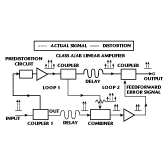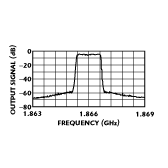A PCS Multicarrier Linear Power Amplifier
Amplidyne Inc. Somerset, NJ
The rapidly expanding personal communications service (PCS) wireless market has created an urgent need for multicarrier linear power amplifiers (MCLPA). Traditionally, base stations have used single-channel amplifiers that required bulky autotuned cavity combiners for each transmit channel. As the number of channels grows, this approach becomes hardware-intensive and bulky. However, an MCLPA eliminates the need for this additional hardware by using a single multicarrier amplifier. Thus, the base station configuration is simplified.
When multiple signals are transmitted through an amplifier, distortion products appear due to third-, fifth- and seventh-order intermodulation distortion (IMD) products. Consider a simple case of two tones (f1 and f2) generating third-order intermodulation products. Second harmonics of these tones exist at 2f1 and 2f2. Third-order terms exist at 2f2 – f1 and 2f1 – f2. The third-order intercept point IP3 is computed using the equation IP3 = single carrier level + IMD/2 (dBm).
For a multiple-tone system, the distortion pattern produced by an amplifier appears as shown in Figure 1 .  In a communication system, the IMD products appear in an adjacent channel and cause adjacent-channel interference. These undesirable intermodulation products must be removed to levels below –60 to –70 dBc for most communication systems to minimize adjacent-channel interference. The MCLPA uses techniques such as predistortion and feedforward cancellation to minimize the intermodulation products.
In a communication system, the IMD products appear in an adjacent channel and cause adjacent-channel interference. These undesirable intermodulation products must be removed to levels below –60 to –70 dBc for most communication systems to minimize adjacent-channel interference. The MCLPA uses techniques such as predistortion and feedforward cancellation to minimize the intermodulation products.
Operating Systems
The PCS system operates in the 1930 to 1990 MHz transmit frequency band in the US (PCS-1900). In many emerging markets worldwide the digital communications system (DCS)-1800, operating in the 1810 to 1870 MHz frequency band, is predominant. The protocols being supported are code-division multiple access (CDMA) and time-division multiple access in the US. Global Systems for Mobile communications are popular in Europe and other areas of the world.
Description
Figure 2 shows a block diagram of the feedforward amplifier system. The main high power amplifier is biased in a quasi class AB mode to maintain good IMD performance and reasonable efficiency.  The peak envelope power capability of this amplifier is in excess of 250 W for an operating average power level of 25 W. In certain digital formats supported by this amplifier, peak signals can be as high as 13 dB above the average power. Since the modulation in such systems is quadrature phase-shift keying, the distortion generated begins to increase rapidly. Therefore, the feedforward system must be designed to remove this distortion.
The peak envelope power capability of this amplifier is in excess of 250 W for an operating average power level of 25 W. In certain digital formats supported by this amplifier, peak signals can be as high as 13 dB above the average power. Since the modulation in such systems is quadrature phase-shift keying, the distortion generated begins to increase rapidly. Therefore, the feedforward system must be designed to remove this distortion.
The amplifier consists of two loops and automatic control circuitry, which maintains cancellation of distortion products over temperature, frequency and power supply variation.  Loop 1 generates an error signal by adjusting amplitude and phase control circuits in the loop. The error signal is amplified in Loop 2 and added out phase with suitable delay to cancel the error at the output port. The amplitude and phase control circuits are adjusted automatically by the control circuits. As a result, the main amplifier’s feedforward corrected output signal is improved significantly, as shown in Figure 3 .
Loop 1 generates an error signal by adjusting amplitude and phase control circuits in the loop. The error signal is amplified in Loop 2 and added out phase with suitable delay to cancel the error at the output port. The amplitude and phase control circuits are adjusted automatically by the control circuits. As a result, the main amplifier’s feedforward corrected output signal is improved significantly, as shown in Figure 3 .
CDMA Signal Performance
Since CDMA signals employ spread spectrum techniques, they can be simulated with bandpass-filtered white noise. Test models for a base station, as defined in the PN-3383 and SP-3384 specifications, consist of one pilot channel, one sync channel, one paging channel and six traffic channels. 
When a CDMA signal passes through an amplifier, third-, fifth- and seventh-order distortion signals occur, which translate into an increase in the frequency spectrum at the output of active devices. This phenomenon is known as spectral regrowth. Excessive spectral regrowth can cause interference between closely spaced CDMA channels. Figure 4 shows the spurious emission requirements of PCS CDMA signals as per PN-3383 and SP-3384. 
Figure 5 shows the single-output CDMA signal performance of the feedforward amplifier. The peak-to-average power for a CDMA signal is high; this condition must be simulated accurately in order to obtain accurate data.
Multicarrier Performance
As system integrators demand that more  information be transmitted in a given bandwidth, closely spaced CDMA signals are employed. Under these conditions, the MCLPA operates in a severe environment. Figure 6 shows the amplifier output with two CDMA signals. The 25 W module specification is listed in Table 1 .
information be transmitted in a given bandwidth, closely spaced CDMA signals are employed. Under these conditions, the MCLPA operates in a severe environment. Figure 6 shows the amplifier output with two CDMA signals. The 25 W module specification is listed in Table 1 .
A Combiner Shelf
Up to four modules can be inserted into the combiner shelf (model AMP1960-100S). The gain in the shelf is 53 dB and power output is 20, 40, 70 and 90 W for one, two, three and four modules, respectively. The gain is constant at 53 ±1 dB regardless of how many modules are inserted. The shelf consists of intelligent combiners and dividers. Options are available for providing status with an RS-422 interface. Shelf size is 27" x 17" x 16". Delivery: 12 weeks (ARO).
|
Table 1 - Specifications for the 25 W MCLPA | |
|
Model |
AMP 1960-25F AMP 1855-25F Amp 1890-1870 MHz |
|
Frequency (MHz) |
1930 to 1990 or 1840 to 1870 |
|
Gain (dB) |
58±1 |
|
Multitone IMD (dBc) |
-60 |
|
Input voltage range (V) |
21 to 29 |
|
Operating temperature range (°C) |
0 to 60 |
|
Current at 27 V DC (A) |
19 |
|
Alarms |
over temp, fan fail, loop fail, over power* |
|
Size |
5.9" x 16.3" x 15.0" |
* A multitude of custom options are available
Amplidyne Inc., Somerset, NJ (908) 271-8473.
